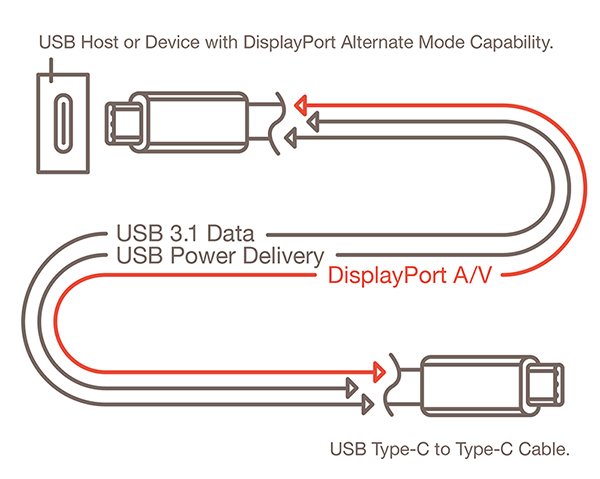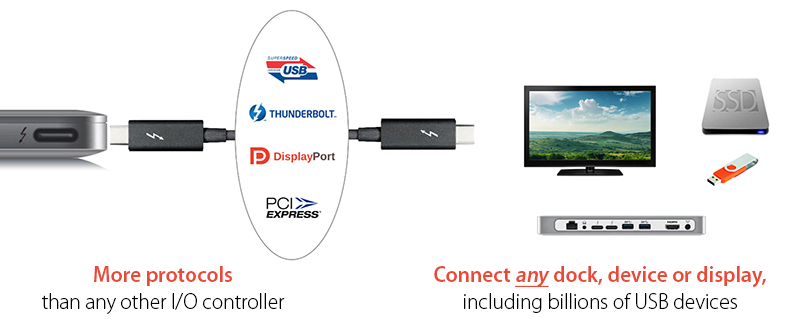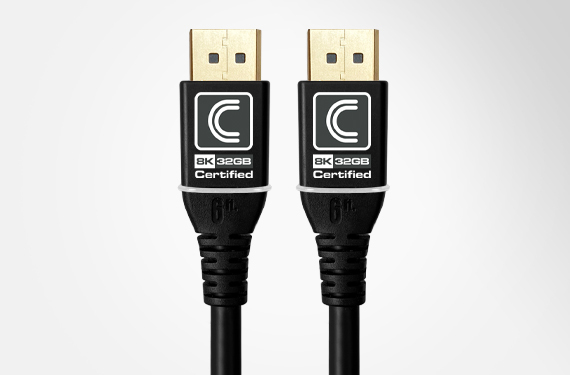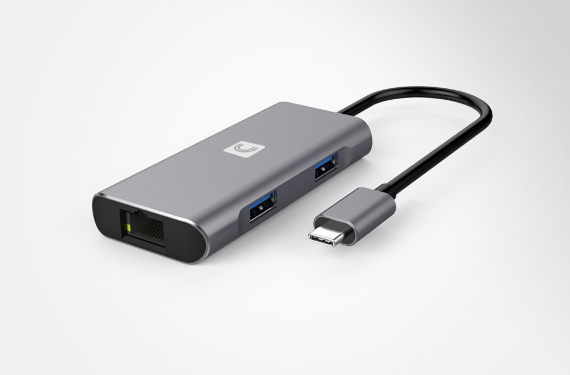
DisplayPort™ 1.4
Ready for 8K@60Hz and 4K@120Hz HDR Displays and USB Type-C Integration! DisplayPort™ 1.4 is the first version of the protocol to include support for VESA’s Display Stream Compression (DSC) technology; guaranteed by VESA to be visually lossless while achieving up to a 3:1 compression ratio.
Ready for 8K@60Hz and 4K@120Hz HDR Displays and USB Type-C Integration! DisplayPort™ 1.4 is the first version of the protocol to include support for VESA’s Display Stream Compression (DSC) technology; guaranteed by VESA to be visually lossless while achieving up to a 3:1 compression ratio.
DisplayPort 1.4 Features
 One of the major new features of DisplayPort 1.4 is that it also compatible with Intel Thunderbolt™ and USB Type-C™ interfaces, which means next-generation monitors could connect to your system with a single, tiny cable with a USB Type C connector. Together with other new capabilities, this makes the latest version of DP ideally suited for implementation in high-end electronic products demanding premier sound and image quality.
One of the major new features of DisplayPort 1.4 is that it also compatible with Intel Thunderbolt™ and USB Type-C™ interfaces, which means next-generation monitors could connect to your system with a single, tiny cable with a USB Type C connector. Together with other new capabilities, this makes the latest version of DP ideally suited for implementation in high-end electronic products demanding premier sound and image quality.
The new DP 1.4 specification will support 5120×2880 @60Hz with high dynamic range, and up to 8K (7680×4320)@60Hz with use of 4-2-0 pixel structure in both high dynamic range and standard modes. DisplayPort 1.4 also enables the simultaneous use of two 4K UHD monitors, each with a pixel resolution of up to 3840 x 2160. Gamers who prefer high refresh rates and high resolutions aren’t forgotten; DP 1.4 can also drive “deep color” 120Hz 4K panels. If you have a need for high-definition, 32-channel audio, DP 1.4 also has you covered.
DisplayPort 1.4 with Intel Thunderbolt™ and USB Type-C™

Figure 1: Shows transmission route using Alternate Mode (photo courtesy of displayport.org)

Figure 2: Shows transmission protocol using Thunderbolt3 technology from Intel (photo courtesy of anandtech.com)

Figure 1: Shows transmission route using Alternate Mode (photo courtesy of displayport.org)

Figure 2: Shows transmission protocol using Thunderbolt3 technology from Intel (photo courtesy of anandtech.com)
DisplayPort 1.4 Highlights
- 8K x 4K display support with use of 4:2:0 pixel structure (good) or VESA Display Stream Compression (better)
- Supports 5K (5120 x 2880) display support without compression with simultaneous USB 2.0
- Supports 4K @60Hz 24-bit color (without compression) with simultaneous USB 3.1
- Support for BT.2020 color space, HDR, and HDCP 2.2
- USB Type C / Thunderbolt integration through “Alternate Mode”
- Backward compatible with VGA, DVI, and HDMI 2.0 with CEC using plug adapters or adapter cables
- Forward Error Correction – FEC, which overlays the DSC 1.2 transport, addresses the transport error resiliency needed for compressed video transport to external displays.
- HDR meta transport – HDR meta transport uses the “secondary data packet” transport inherent in the DisplayPort standard to provide support for the current CTA 861.3 standard, which is useful for DP to HDMI 2.0a protocol conversion, among other examples. It also offers a flexible metadata packet transport to support future dynamic HDR standards.
- Simultaneous use of two 4K monitors, each with a pixel resolution up to 3840 x 2160
- Expanded audio transport – it covers capabilities such as 32 audio channels, 1536kHz sample rate, and inclusion of all known audio formats.
DP 1.4 Solutions from Comprehensive
Comprehensive's DisplayPort 1.4 Solutions are the cutting edge in technology and reliability. State-of-the-art performance with up to stunning ultra-high 8K resolution, 40G bandwidth, dynamic HDR and USB Type-C/Thunderbolt integration through “Alternate Mode”.
Comprehensive's DisplayPort 1.4 Solutions are the cutting edge in technology and reliability. State-of-the-art performance with up to stunning ultra-high 8K resolution, 40G bandwidth, dynamic HDR and USB Type-C/Thunderbolt integration through “Alternate Mode”.
DisplayPort 1.4 FAQs
Q: Does the release of DisplayPort 1.4 mean that DisplayPort 1.2 products are phased out?
A: Not at all. VESA develops and publishes standards like DisplayPort prior to their actual deployment in the field. DisplayPort 1.2a represents the latest interconnect technology now available to consumers from manufacturers. The new DisplayPort capabilities included in DisplayPort 1.4 have begun the cycle of hardware development that will result in such technology becoming available to consumers in a range of products over the next few years. And like other new versions of DisplayPort, DisplayPort 1.4 is backward compatible with earlier DisplayPort standards.
Q: When will I be able to buy products that use DisplayPort 1.4?
A: Products that support new DisplayPort features defined in DisplayPort 1.4 should become available in 2017. Early implementations could very likely use DisplayPort Alt Mode over USB Type-C.
Q: Does this mean that with the addition of DisplayPort over USB-C, I can still expect the same USB data and USB Power Delivery capabilities across USB Type-C connector?
A: Yes. DisplayPort, USB data, and USB Power Delivery can all be carried simultaneously through the same USB Type-C connector and cable. This is supported by a standard full-featured USB Type-C cable.
Q: Can DisplayPort over USB-C provide the same level of performance and features as the standard DisplayPort connection?
A: Yes. the same as in standard DisplayPort connectors and cables, DisplayPort over USB-Type-C can take advantage of the four high-speed data lanes in the USB Type-C connector and corresponding cable to be able to provide 4K display resolutions and beyond.
Q: How will I know if the Type-C connector on my device supports DisplayPort over USB-C?
A: USB Type-C connectors and cables that support the DisplayPort over USB-C functionality will usually include the DisplayPort (DP) logo near or on the connector.
Q: Can I connect a DisplayPort 1.4 device to a new television that supports HDMI 2.0?
A: DisplayPort 1.4 adapters will enable DisplayPort source devices to support HDMI 2.0 for 4K UHD with up to 60Hz refresh and up to full 24-bit color with the 4:4:4 pixel format.
Q: Does DisplayPort 1.4 enable support for the latest content protection?
A: Yes, DisplayPort 1.4 enables support for HDCP version 2.2. This requirement will apply to DisplayPort-to-HDMI 2.0 converters as well (including USB Type-C to HDMI 2.0 converters that utilize DisplayPort Alt Mode).
Q: How will I know if my device supports new DisplayPort 1.4 features?
A: Vendor packaging and on-line information should indicate the DisplayPort features supported for each product.
Q: Will DisplayPort Alt Mode on the Type-C connector support DisplayPort 1.4?
A: Yes. All of the features associated with DisplayPort 1.4 will be available for the DisplayPort Alt Mode.
Q: Does DisplayPort 1.4 still support adapters to VGA, DVI and HDMI?
A: Yes.
Q: Will Thunderbolt, which uses DisplayPort for video, support DisplayPort 1.4?
A: It is expected that other interconnect technologies that use DisplayPort as a video transport will adopt the DisplayPort 1.4 features.
Original Source Material from DisplayPort.org
A: Not at all. VESA develops and publishes standards like DisplayPort prior to their actual deployment in the field. DisplayPort 1.2a represents the latest interconnect technology now available to consumers from manufacturers. The new DisplayPort capabilities included in DisplayPort 1.4 have begun the cycle of hardware development that will result in such technology becoming available to consumers in a range of products over the next few years. And like other new versions of DisplayPort, DisplayPort 1.4 is backward compatible with earlier DisplayPort standards.
Q: When will I be able to buy products that use DisplayPort 1.4?
A: Products that support new DisplayPort features defined in DisplayPort 1.4 should become available in 2017. Early implementations could very likely use DisplayPort Alt Mode over USB Type-C.
Q: Does this mean that with the addition of DisplayPort over USB-C, I can still expect the same USB data and USB Power Delivery capabilities across USB Type-C connector?
A: Yes. DisplayPort, USB data, and USB Power Delivery can all be carried simultaneously through the same USB Type-C connector and cable. This is supported by a standard full-featured USB Type-C cable.
Q: Can DisplayPort over USB-C provide the same level of performance and features as the standard DisplayPort connection?
A: Yes. the same as in standard DisplayPort connectors and cables, DisplayPort over USB-Type-C can take advantage of the four high-speed data lanes in the USB Type-C connector and corresponding cable to be able to provide 4K display resolutions and beyond.
Q: How will I know if the Type-C connector on my device supports DisplayPort over USB-C?
A: USB Type-C connectors and cables that support the DisplayPort over USB-C functionality will usually include the DisplayPort (DP) logo near or on the connector.
Q: Can I connect a DisplayPort 1.4 device to a new television that supports HDMI 2.0?
A: DisplayPort 1.4 adapters will enable DisplayPort source devices to support HDMI 2.0 for 4K UHD with up to 60Hz refresh and up to full 24-bit color with the 4:4:4 pixel format.
Q: Does DisplayPort 1.4 enable support for the latest content protection?
A: Yes, DisplayPort 1.4 enables support for HDCP version 2.2. This requirement will apply to DisplayPort-to-HDMI 2.0 converters as well (including USB Type-C to HDMI 2.0 converters that utilize DisplayPort Alt Mode).
Q: How will I know if my device supports new DisplayPort 1.4 features?
A: Vendor packaging and on-line information should indicate the DisplayPort features supported for each product.
Q: Will DisplayPort Alt Mode on the Type-C connector support DisplayPort 1.4?
A: Yes. All of the features associated with DisplayPort 1.4 will be available for the DisplayPort Alt Mode.
Q: Does DisplayPort 1.4 still support adapters to VGA, DVI and HDMI?
A: Yes.
Q: Will Thunderbolt, which uses DisplayPort for video, support DisplayPort 1.4?
A: It is expected that other interconnect technologies that use DisplayPort as a video transport will adopt the DisplayPort 1.4 features.
Original Source Material from DisplayPort.org




